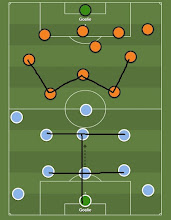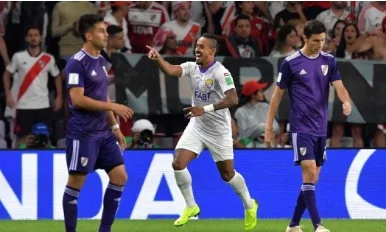Several teams have reached the
finals in the FIFA Club World Cup despite not being considered the favorites,
making them the unlikely finalists in the tournament’s history.
The 2025 FIFA CWC has come to the
final four. As expected, the European sides are still dominating, with three
clubs battling for two spots in the summit. The current UCL and UEFA Conference
League winners, PSG and Chelsea, alongside the continental and global serial
winner, Real Madrid, are taking the three berths in the semifinal, whereas the
other one belongs to Brazil’s Fluminense.
Renato Pantaluppi’s men were tipped
with fortune in the quarterfinals. They only faced Al Hilal, which had downed
Manchester City in an epic 4–3 comeback win in the round of 16. The Saudi Pro
League side was expected to be the unlikely finalist in this CWC edition and go
further, but sadly they failed. Simone Inzaghi’s men were unable to ease past
Fluminense, as they were beaten 2–1.
Had Al Hilal lost to Pep Guardiola’s
men, Fluminense would have had tougher opposition to face and might have been
defeated by the 2023 UCL winner. In a different yet more shocking scenario, Al
Hilal, as the only team in the round of 8 from outside Europe and South
America, could have replicated their success in the 2022 edition, had they
managed to see off Fluminense and then perhaps Chelsea—considering their form
in holding Real Madrid to a 1–1 tie in the opener, plus the comeback victory
over Manchester City. Unfortunately, that did not happen.
With the current expanded format of
the FIFA CWC, it is getting more challenging for North American, African, and
Asian clubs to reach the final, as they have more steps to take and face more
established teams. Thus, unlikely finalists are seemingly unlikely to be seen
in the foreseeable future. Here are those unlikely finalists in FIFA CWC
history, who you might not see again—unless a miracle happens.
African
Teams (TP Mazembe & Raja Casablanca)
The first unlikely finalist was
beyond everyone’s imagination: Congolese side TP Mazembe. The 2010 CAF
Champions League winner managed to see off two teams from the American
continent—CONCACAF side Pachuca and Copa Libertadores champion Internacional.
In the quarterfinal, they edged the former 1–0 before dismantling the latter—also
the 2006 FIFA CWC winner—2–0.
The semifinal was one of the most stunning matches, as it could have been a perfect final between Internazionale Milan and Internacional de Porto Alegre. Unfortunately, lady luck was not on the Brazilian side. TP Mazembe fought heroically to crush their dream. The key man in the match was goalkeeper Robert Kidiaba, who was also famous for his unique "donkey dance" celebration. The former Congolese international made two crucial saves to frustrate Andrés D’Alessandro and Co., and even provided an assist for the second goal in the 85th minute with a long ball on a quick counterattack.
Unfortunately, they were hapless in the final, as Inter Milan proved to be far too strong. Goran Pandev and Samuel Eto’o broke the deadlock within 20 minutes before substitute Jonathan Biabiany added a third to seal the win. Nevertheless, Mazembe’s unexpected progress is boldly written in the tournament’s history.
Another African side that managed to
reach the final was Raja Casablanca. The Moroccan team did it in the 2013
edition. They competed in the tournament as hosts, instead of CAF Champions
League winners. Thus, they started from the playoff round, beating Auckland
City 2–1. In the quarterfinal, Faouzi Benzarti’s men sent CONCACAF team Monterrey
home with a narrow 2–1 win in extra time.
However, it was the semifinal that
was most memorable, as they took on Ronaldinho’s Atlético Mineiro. The
Brazilian side was undoubtedly the favorite on paper. On the pitch, it was a
different story. Raja Casablanca took the lead early in the second half through
a swift counterattack that led to Mouchine Iajour’s goal. Ronaldinho then put
his team back on level terms with his specialty—a free kick. Unfortunately,
Atlético Mineiro conceded again from another counterattack. The first led to a
foul in the six-yard box. Mohsine Moutouali converted the penalty, and Vianney
Mabidé scored the third from a rebound.
In the final, they were still no
match for UCL winners Bayern Munich. Under the tutelage of Pep Guardiola, Die
Roten had no trouble beating Raja Casablanca 2–0. Dante and Thiago Alcântara
scored the winning goals in the first half. The hosts were unable to even score
a consolation goal before the final whistle.
Asian
Teams (Kasima Antlers, Al Ain & Al Hilal)
The next unlikely finalists came from Asia. Three teams have reached the final: Japan’s Kashima Antlers, UAE’s Al Ain, and Saudi Arabia’s Al Hilal.
Kashima Antlers reached the 2016 final as hosts. They began their campaign in the playoff round, defeating Auckland City 2–1 and CAF side Mamelodi Sundowns 2–0. In the semifinal, Antlers faced off against CONMEBOL’s Atlético Nacional. The game was tight at first, but the Japanese side managed to pull away with a convincing 3–0 victory. Shoma Doi opened the scoring with a penalty in the first half. Yasushi Endo and Yuma Suzuki added two more in the last five minutes.
Their performance in the final
stunned everyone, including their opponents Real Madrid. Los Blancos took an
early lead in the 9th minute through Karim Benzema, following a rebound from
Hitoshi Sogahata’s block on Luka Modrić’s shot.
Real Madrid appeared to be cruising,
but Antlers equalized through Gaku Shibasaki just before halftime. He even
added a second to give his team the lead. Zinedine Zidane’s men had to rely on
a penalty to draw level—Cristiano Ronaldo converted with ease. The game went
into extra time, where Ronaldo bagged a brace to seal the win.
Interestingly, the other two Asian
sides also faced Real Madrid in the final. Al Ain did so in 2018, and Al Hilal
in 2022.
Al Ain stunned the world by
replicating Antlers’ success. Zoran Mamić’s men knocked out the favorites,
River Plate, in the semifinals on penalties after holding them to a 2–2 draw
for 120 minutes. They had previously eliminated Team Wellington and Espérance
Tunis. Marcus Berg opened the scoring in the 3rd minute, but River Plate responded
with two goals by Colombian striker Rafael Borré. Caio equalized early in the
second half. In the shootout, both teams converted well until Enzo Pérez’s
effort was denied by Al Ain keeper Khalid Eisa. In the final, however, Al Ain looked out of their depth. Real Madrid humbled
them 4–1, despite not being in top form that season following the departures of
Zidane and Cristiano Ronaldo.
Meanwhile, Al Hilal’s 2022 campaign was somewhere between Antlers and Al Ain. The Saudi side didn’t start strongly, needing penalties to overcome Wydad Casablanca in the playoff. In the semifinal, they beat Flamengo 3–2, helped by two penalties converted by Salem Al-Dawsari—known for scoring in Saudi Arabia’s historic 2–1 win over Argentina in the 2022 FIFA World Cup.
In the final, Ramón Díaz’s side were trailing 4–1 by the hour mark after being
overrun by Karim Benzema and Co. But they clawed back through a brace from
Luciano Vietto. Though Madrid added another to win 5–3, the match is remembered
as one of the most entertaining finals in tournament history.
North
American Teams (UANL & Pachuca)
In
the last five years, CONCACAF teams have become serious contenders against
South American sides on the global stage. Their Champions League winners have
posed more consistent threats than most Asian representatives.
In the FIFA CWC/Intercontinental
Cup, two North American clubs—UANL and Pachuca—have reached the final recently.
UANL did it in 2020, while Pachuca earned their shot in the new
Intercontinental Cup, the annual tournament replacing the old FIFA CWC format.
UANL had a slightly better campaign.
Guido Pizarro and Co. beat Ulsan Hyundai 2–1 in the playoff round and then
edged Flamengo 1–0 in the semifinal. In the final, they managed to match Bayern
Munich for long spells, losing only 1–0 to a Benjamin Pavard goal from a
rebound. It was initially ruled out but later confirmed by VAR.
Pachuca, on the other hand, began strongly with a 3–0 win over Botafogo in the regional round. In the decisive
playoff against Al Ahly, they needed penalties after a goalless draw. In the
final, they were outmatched by Real Madrid, losing 3–0.


Comments
Post a Comment